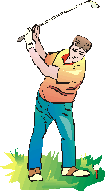Why Is Too Slow A Backswing Bad?
You need a fast enough backswing that is a ratio of 1 to 3 with a downswing to hit the ball a long way. The backswing sets up the speed of the downswing. Too slow a backswing will not develop enough clubhead speed to be able to hit the ball with any distance.
In golf, the backswing is a crucial part of the swing that can have a significant impact on the outcome of the shot. The backswing is the initial movement of the golf club away from the ball, which sets up the swing’s mechanics. Many golfers struggle with a slow backswing, which can negatively affect their swing and ultimately lead to poor shots. In this article, we will explore why a slow backswing is bad and how it can impact your golf game.
The first reason why a slow backswing is bad is that it can lead to inconsistent shots. When a golfer takes too much time to complete their backswing, it can throw off their timing and rhythm, which can result in inconsistent contact with the ball. A slow backswing can also cause a golfer to lose their balance and posture, which can further impact their swing’s mechanics. This inconsistency can make it difficult for a golfer to predict where the ball will go and may lead to a loss of confidence in their game.
Secondly, a slow backswing can cause a golfer to lose power and distance in their shots. In golf, generating power is crucial to hit the ball further and achieve better results. A slow backswing can cause a golfer to lose power because it disrupts the flow of energy from the club to the ball. When a golfer takes too long to complete their backswing, they lose the momentum needed to generate power in their swing. This can result in weaker shots that do not travel as far as they should.
Thirdly, a slow backswing can lead to swing faults. When a golfer takes too long to complete their backswing, they may overcompensate by rushing their downswing, which can cause swing faults. For example, a golfer may have a tendency to swing over the top or across the ball, resulting in slices and hooks. These swing faults can lead to further frustration and inconsistency for the golfer.
Fourthly, a slow backswing can impact a golfer’s tempo and rhythm. Golf is a game of tempo, and a slow backswing can disrupt a golfer’s natural rhythm. When a golfer takes too much time to complete their backswing, they may rush their downswing, resulting in a swing that is out of sync. This can make it difficult for a golfer to find their tempo and may cause further inconsistency in their shots.
Lastly, a slow backswing can lead to mental fatigue and frustration. Golf is a mental game, and a slow backswing can cause a golfer to become frustrated and fatigued. When a golfer takes too long to complete their backswing, it can disrupt their mental focus and make it difficult to stay engaged in the game. This mental fatigue can lead to further inconsistency and frustration for the golfer.
So, what can a golfer do to fix a slow backswing? Firstly, they can work on their grip and setup to ensure they are in the correct position to start the swing. Secondly, they can practice their backswing to improve their timing and rhythm. This can involve using a metronome or practicing with a swing trainer to develop a consistent tempo. Thirdly, they can work on their flexibility to ensure they can complete a full backswing without losing balance or posture. Lastly, they can seek the help of a golf instructor to identify any swing faults and develop a plan to fix them.
In conclusion, a slow backswing can have a significant impact on a golfer’s game, leading to inconsistent shots, loss of power and distance, swing faults, disruption of tempo and rhythm, and mental fatigue and frustration. Golfers who struggle with a slow backswing can work on their grip, setup, timing, flexibility, and seek the help of a golf instructor to fix the issue.
It’s important to note that a slow backswing doesn’t necessarily mean that a golfer is taking too much time to complete their swing. Instead, it’s about maintaining a consistent tempo and rhythm throughout the entire swing. A golfer can have a slow backswing as long as they maintain a consistent tempo and rhythm in their swing. However, if a golfer has a slow backswing that disrupts their timing and rhythm, it can negatively impact their game.
To help improve their backswing, golfers can also incorporate drills and exercises into their practice routine. One such drill is the “pause and go” drill, where a golfer takes their club back to the top of their backswing, pauses for a few seconds, then completes their swing. This drill helps to develop a consistent tempo and timing in the swing. Another exercise that can help improve the backswing is stretching and flexibility exercises, such as shoulder and hip stretches, to help ensure a full and smooth backswing.
Ultimately, a slow backswing can be detrimental to a golfer’s game, causing inconsistency in their shots, loss of power and distance, swing faults, disruption of tempo and rhythm, and mental fatigue and frustration. However, golfers can work on their grip, setup, timing, flexibility, and seek the help of a golf instructor to improve their backswing and ultimately improve their overall game. By practicing and developing a consistent tempo and rhythm in their swing, golfers can achieve better results and enjoy the game more.





